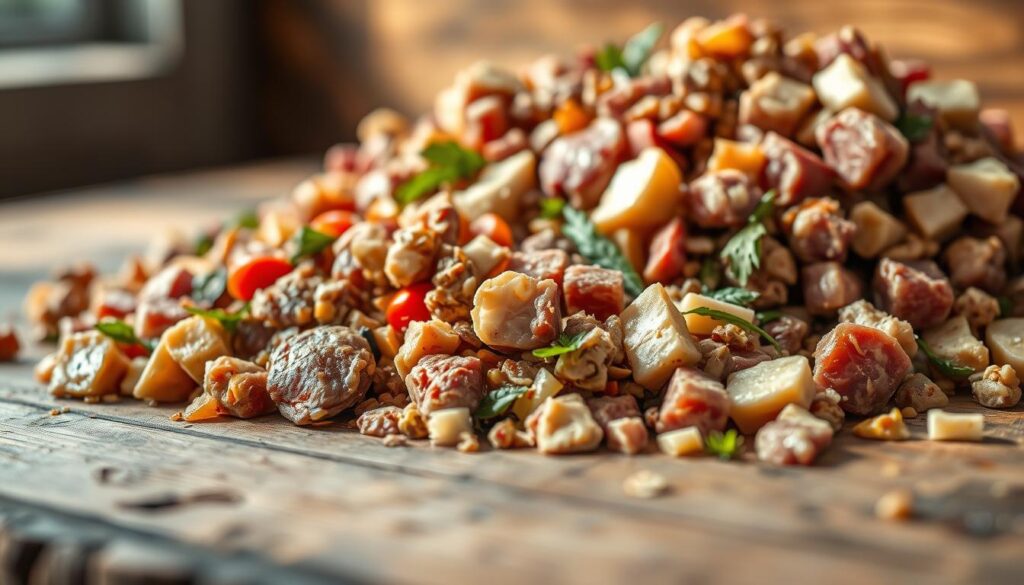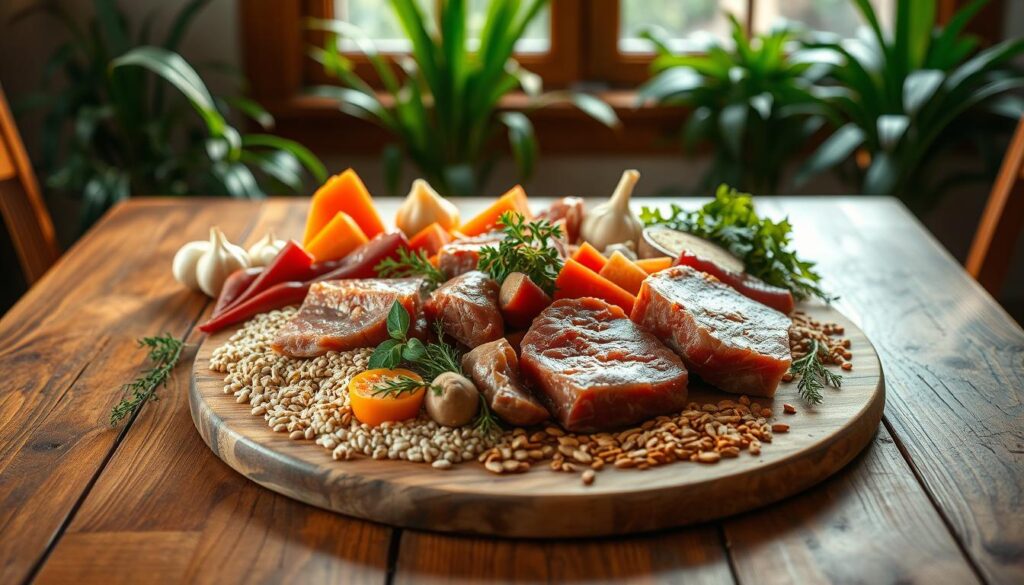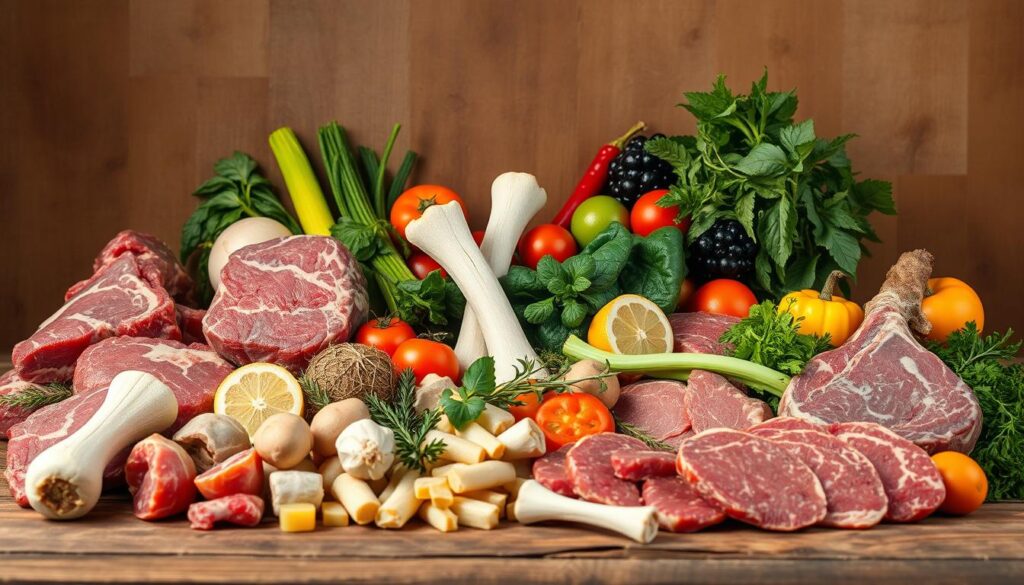As a dog owner, you want the best for your pet. Raw dog food, made from uncooked, natural ingredients, is thought to be a better choice. It’s meant to be like what wild dogs eat, with fresh meat, bones, and whole foods. This diet is believed to be healthier for dogs.

Thinking about a raw diet for your dog? It’s good to know the benefits. Yes, raw dog food is made from uncooked, natural ingredients. It’s believed to give dogs a more natural and healthy diet. Feeding your dog raw can help them stay healthy and happy.
Key Takeaways
- Raw dog food is made from uncooked, natural ingredients.
- Raw dog food is believed to provide a more natural diet for dogs.
- Uncooked dog food can be beneficial for a dog’s overall health.
- A raw diet can provide dogs with the nutrients they need to thrive.
- Raw dog food is designed to mimic the natural diet of wild dogs.
Understanding Raw Dog Food Fundamentals
Thinking about switching your dog to a raw diet? It’s key to know the basics of raw dog food. Raw pet nutrition aims to give dogs a natural diet like their ancestors. It uses natural ingredients like meat, bones, and whole foods for a balanced diet.
Raw dog food has several important parts. It includes protein sources like meat and eggs, and fruits and vegetables too. Many dog owners see big health improvements after switching to raw dog food.

Raw dog food offers many benefits. It can improve digestion, make skin and coat healthier, and boost energy. A natural dog food diet supports your dog’s health and well-being. If you want to improve your dog’s health or give them a natural diet, raw pet nutrition is worth exploring.
Here are some key things to remember about raw dog food:
- Always choose high-quality, natural ingredients
- Ensure a balanced diet that meets your dog’s nutritional needs
- Consult with a veterinarian before making any changes to your dog’s diet
By following these tips and doing your research, you can give your dog a healthy raw dog food diet. This diet will meet their unique needs and support their health and well-being.
Is Raw Dog Food Made From Uncooked, Natural Ingredients and Believed to Provide Better Nutrition?
Thinking about a raw diet for your dog? It’s key to know its nutritional perks. Raw dog food uses uncooked, natural stuff. It’s thought to give dogs better nutrition, with protein, fat, and carbs.
This diet is packed with vitamins and minerals. They’re vital for your dog’s health. A raw diet can help with digestion, lower disease risks, and boost overall health.
Some top perks of a raw diet include:
- Improved digestion
- Reduced risk of chronic diseases
- Healthier skin and coat
- Increased energy levels
But, a raw diet isn’t for every dog. Always talk to a vet before switching your dog’s food. Yet, many owners find it a great way to nourish their pets.

Choosing a raw diet can make your dog’s life better. With the right nutrients and a focus on holistic pet care, you’re giving your dog a great start.
Essential Components of Raw Dog Food Diets
Raw dog food diets are key for your dog’s health. They include muscle meat, organ meat, bones, and fruits and veggies. These parts give your dog the protein, vitamins, and minerals they need.
Muscle meat is full of protein, which is vital for your dog’s body. Organ meat, like liver and kidney, adds important vitamins and minerals. Bones give calcium and minerals for strong bones and teeth. Fruits and veggies add fiber, vitamins, and minerals for health.
Raw dog food diets offer many benefits. They improve digestion, make skin and coats healthier, and boost energy. This natural diet can help prevent chronic diseases and keep your dog at a healthy weight.
To make sure your dog gets a balanced diet, consider these key parts:
- Muscle meat: provides protein for building and repairing tissues
- Organ meat: provides essential vitamins and minerals
- Bone content: provides calcium and other minerals for healthy bones and teeth
- Fruits and vegetables: add fiber, vitamins, and minerals for overall health and well-being
Benefits of Switching to Raw Dog Food
As a dog owner, you want the best for your pet. A nutritious diet is key. Raw dog food offers many benefits for your dog’s health and happiness. It can improve digestion, boost energy, and make their coat shine.
Raw dog food is packed with vitamins and minerals. These are crucial for your dog’s health. A raw diet can also lower the risk of chronic diseases and support overall health.
Raw dog food is rich in vitamins and minerals. These are vital for good health. Feeding your dog a raw diet can improve digestion and lower the risk of food allergies and sensitivities. Some of the key benefits of raw dog food include:
- Improved digestion and reduced risk of digestive issues
- Increased energy and vitality
- A shinier, healthier coat
- Reduced risk of chronic diseases
- Support for overall health and well-being
A holistic pet nutrition approach helps you make better diet choices. By considering the benefits of raw dog food, you can support your dog’s health.
Adding raw dog food to your dog’s diet is a great way to ensure they get the nutrients they need. With the benefits of raw dog food and a holistic approach, your dog can live a happy and healthy life.
| Benefits of Raw Dog Food | Description |
|---|---|
| Improved Digestion | Reduced risk of digestive issues |
| Increased Energy | Improved vitality and overall health |
| Shinier Coat | Healthier, more vibrant coat |
Potential Risks and Safety Considerations
Switching to raw dog food comes with risks and safety steps. Raw dog food, or uncooked dog food, can be contaminated with bacteria. As a dog owner, it’s important to take steps to keep your dog safe and healthy.
The main risk is bacterial contamination, especially from Salmonella and E. coli. To avoid this, handle raw dog food safely. Store it in a cool, dry place and wash your hands well after touching it. Also, make sure your dog gets all the vitamins and minerals they need from natural dog food.
- Handling and storing raw dog food properly to prevent bacterial contamination
- Ensuring your dog’s diet is nutritionally balanced and complete
- Monitoring your dog’s health and adjusting their diet as needed
Knowing these risks and taking steps to prevent them can make a raw dog food diet safe and healthy for your pet.
Transitioning Your Dog to Raw Food
Switching to a raw diet for your dog needs careful planning. A raw diet can make your dog’s digestion better and their coat shinier. Start by adding small amounts of raw food to their meals and gradually increase it.
This slow introduction helps your dog get used to the new diet without upset stomachs. You can mix a little raw food with their usual meals. This way, they can get used to the taste and texture. Keep an eye on how your dog reacts to the new diet, watching for any health issues.
- Introduce new ingredients slowly and in small amounts
- Monitor your dog’s health and adjust the transition process as needed
- Consider consulting with a veterinarian or canine nutritionist for personalized guidance
By following these tips and being patient, you can help your dog thrive on a raw diet. They will enjoy the benefits of raw food, and so will you.
Storage and Preparation Guidelines
Storing and preparing raw dog food is crucial for your dog’s health. Raw dog food needs careful handling to avoid contamination and spoilage. Natural dog food, with its high moisture, is more likely to spoil.
To store raw dog food, use a cool, dry spot like a fridge or freezer. This stops bacteria from growing and keeps the food fresh. Always wash your hands well when thawing raw dog food and avoid mixing it with other foods.
Key Storage and Preparation Tips
- Store raw dog food in a sealed container to prevent moisture and other contaminants from entering.
- Keep raw dog food away from cooked and ready-to-eat foods to prevent cross-contamination.
- Thaw frozen raw dog food in the refrigerator or cold water, never at room temperature.
- Serve raw dog food immediately after thawing, and discard any leftovers after 24 hours.
By following these tips, you can keep your dog healthy and safe. They’ll enjoy the benefits of raw, uncooked, or natural dog food.
Cost Considerations and Budget Planning
Thinking about a raw feeding diet for your dog means looking at the cost. Raw diets can cost more than kibble, but they offer health benefits. Plan your budget for the initial costs, like high-quality ingredients and equipment.
Your dog’s health is key, and a holistic diet can cut vet bills. To lower costs, try these tips:
- Purchasing ingredients in bulk to reduce costs
- Shopping for sales and discounts on raw dog food ingredients
- Preparing meals in advance to save time and money
Choosing a raw diet is a health investment for your dog. The upfront cost may seem steep, but it saves on vet bills and improves health.
Remember, a raw diet is a long-term health investment. Simple changes in shopping and meal prep can make it more affordable. This way, your dog gets the nutrition they need to thrive.
Monitoring Your Dog’s Health on Raw Diet
When you switch your dog to a raw feeding diet, watching their health is key. You should keep an eye on their digestion, energy, and overall health. A raw pet nutrition plan can offer many benefits of raw dog food. But, it’s important to know about possible health problems.
Important health signs to watch include stool quality, appetite, and skin health. If your dog has digestive issues like diarrhea or vomiting, see a vet or nutritionist. They can adjust your dog’s raw feeding diet to meet their nutritional needs.
To help your dog do well on a raw pet nutrition plan, consider these tips:
- Keep a food diary to track your dog’s eating habits and any adverse reactions
- Monitor your dog’s weight and adjust their food intake as needed
- Provide fresh water at all times to ensure proper hydration
By following these tips and working with a vet or nutritionist, your dog can enjoy the benefits of raw dog food. Remember, every dog is unique. It might take some time to find the right raw feeding diet for your pet.
Conclusion: Making an Informed Decision About Raw Feeding
Raw dog food can offer many benefits for your dog. But, it’s crucial to think about the risks and challenges first. Talking to your vet can help you decide if it’s right for your pet.
Choosing a raw diet depends on your dog’s needs and your lifestyle. With careful planning and monitoring, it can be a great choice. This way, you can make sure your dog gets the best from a raw diet.
FAQ
What constitutes raw dog food?
Raw dog food is made from muscle meat, organ meat, bones, and whole foods. It’s meant to be like what wild dogs eat. This includes fresh, uncooked ingredients.
How has the historical evolution of raw feeding shaped the current approach?
Raw feeding has been around since dogs were first domesticated. They were fed scraps and leftovers back then. Now, it’s popular to give dogs a raw diet to keep them healthy.
What are the core components of a raw dog food diet?
A raw dog food diet includes muscle meat, organ meat, bones, fruits, and veggies. These give dogs the nutrients they need to stay healthy.
How does raw dog food differ from traditional dog food in terms of nutritional benefits?
Raw dog food uses natural, uncooked ingredients. It’s thought to be better for dogs because it gives them the nutrients they need. This includes protein, fat, carbs, vitamins, and minerals.
What are the potential benefits of switching to a raw dog food diet?
A raw diet can improve a dog’s health, energy, and coat shine. It’s full of vitamins and minerals. This can also lower the risk of food allergies and sensitivities.
What are the potential risks and safety considerations associated with raw dog food?
Raw dog food can be contaminated with bacteria if not handled right. Owners must make sure the diet is balanced. Safe handling and storage are key.
How can I safely transition my dog to a raw food diet?
Start by adding small amounts of raw food to their diet. Gradually increase it. Watch for any health issues and adjust as needed.
How should I store and prepare raw dog food?
Keep raw dog food cool and dry, like in a fridge or freezer. Wash hands well when thawing. Follow serving sizes and frequencies for the right nutrients.
What cost considerations and budget planning should I keep in mind when switching to a raw dog food diet?
Starting a raw diet can cost a lot, but it can save money in the long run. Buy in bulk, look for sales, and prep meals ahead to save.
How can I monitor my dog’s health on a raw diet?
Watch for signs of upset stomach, skin issues, or other problems. If health issues arise, talk to a vet or nutritionist for advice.
